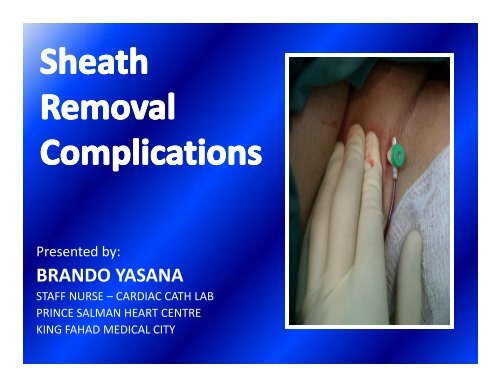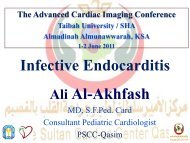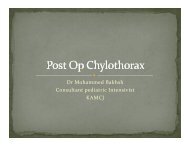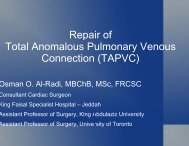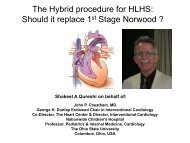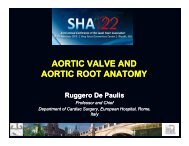BRANDO YASANA - Sha-conferences.com
BRANDO YASANA - Sha-conferences.com
BRANDO YASANA - Sha-conferences.com
- No tags were found...
Create successful ePaper yourself
Turn your PDF publications into a flip-book with our unique Google optimized e-Paper software.
Presented by:<strong>BRANDO</strong> <strong>YASANA</strong>STAFF NURSE –CARDIAC CATH LABPRINCE SALMAN HEART CENTREKING FAHAD MEDICAL CITY
The Sheath
COMPLICATIONS RELATED TO SHEATHREMOVAL‣ Vasovagal Reaction‣ Hematoma‣ Pseudoaneurysm‣ Retroperitoneal Bleeding‣ Vessel Thrombosis‣ Groin InfectionBrando Yasana –SHA 22
VASOVAGAL REACTION‣ Occur when the “vagus” nerve is stimulated‣ Hypotension, Bradycardia, Nausea and Diaphoresis‣ Patient should be connected to:Cardiac MonitorBP Cuff and Pulse OxymeterIV fluid‣ The fluid should be running during sheath removal.Brando Yasana –SHA 22
VASOVAGAL REACTION (cont.)‣ Reaction include a 15 ‐20 mmHg drop in SBP,20 –30 BPM drop in the HR‣ Management :Trendlendburg positionOpen fluidsAtropine / anti‐emeticBrando Yasana –SHA 22
HEMATOMA‣ Anti coagulation, sheath size, poor manualsheath removal technique‣ It will start soft then it will increase in size‣ Early <strong>com</strong>pression will lessen further<strong>com</strong>plications‣ Do good <strong>com</strong>pression if hematomahappened even if there is VCDBrando Yasana –SHA 22
SHEATH REMOVAL APPROACH BEINGUTILIZED AT KFMCBrando Yasana –SHA 22
PSEUDO ANEURYSM‣ Is <strong>com</strong>municationbetween arterial lumenand an area separationwithin the arterial layers‣ Cause:inadequate<strong>com</strong>pression after sheathremoval‣ Diagnosis includepulsatile mass and systolicbruit‣ Can be treated byultrasound guidedfemostop <strong>com</strong>pression
RETROPERITONEAL BLEEDS‣ Potentially fatal <strong>com</strong>plication‣ May occur if femoral artery puncture isproximal to inguinal crease making effective<strong>com</strong>pression very difficult‣ Mayoccurduetoguidewireperforationorsheath dissection.‣ The patient usually <strong>com</strong>plain of acuteabdominal or back pain, tachycardia anddrop of hemoglobin.Brando Yasana –SHA 22
RETROPERITONEAL BLEEDSMANAGEMENT‣ Prolong “Femostop” <strong>com</strong>pression‣ Fluid replacement‣ Blood transfusion‣ Pressure support agent‣ Surgical exploration and correction maybe necessaryBrando Yasana –SHA 22
FEMOSTOPThe Femostop device isused for controlled femoral<strong>com</strong>pression afterintravascular sheathremoval in patients whohave had routine diagnosticcardiac catheterizations,balloon angioplasty,intracoronary stentimplantation and intra-aortic balloon pumpcatheters. It is used as ahemostasis device, andsandbag replacement.
SHEATH REMOVAL APPROACH BEINGUTILIZED AT KFMC‣ .‣<strong>com</strong>pressing the areaBrando Yasana –SHA 22
FACTORS PREDISPOSING TO VASCULAR ACCESSSITE BLEEDING‣ Anatomic Factors‣ Procedural Factors‣ Hemodynamic Factors‣ Hematologic Factors‣ Human Factors
ANATOMIC FACTORS• Calcified vessel• Elderly patient• Obese patient• Female patient• Patient movement
PROCEDURAL FACTOR• Back wall Puncture• High puncture(above inguinal ligament)• Low puncture (profunda or superficial i femoralartery• Multiple puncture• Large sheath size• Kinking of the sheath due to acute angulation• Prolonged procedure time
HEMODYNAMIC FACTORS> Increase pulse pressure> Severe HTN
HEMATOLOGIC FACTOR• Multiple plateletantagonists(ASA,Plavix,IIb,IIIaantagonist)• Antithrombotic agents• Thrombolytic agent• Thrombocytopenia
HUMAN FACTOR• Inexperience• Inability to gain ‘control’ of site uponsheath removal• Short duration of pressure applied toobtain homeostasis• Knowledge of the patient about theprocedure
VESSEL THROMBOSIS‣ Sheath should be removed ASAP.‣ Sheath removal should be done without<strong>com</strong>pressing the shaft and stripping the clotsthat may have formed within.‣ Prolonged occlusive <strong>com</strong>pression should notbe done for more than 5 minutes.Brando Yasana –SHA 22
GROIN INFECTION‣ May occur or may happenspecially with the mechanicalplug homeostasis device.‣ Diabetic and immunosuppressed patient. Patientwith poor hygiene, theelderly and obese patients.‣ Prolong sheath himplantationi
Procedure Done(August - December 2010)37%CA GCA G + PCI63%CAG CAG + PCI TOTAL221 129 350
Sheath Removal Technique(August - December 2010)75%0% 10% 5%5%5%ANGIOSEALSTARCLOSEPERCLOSEFEMOSTOPMA NUA L COMPRESSIONTR BANDTechniqueTotalANGIOSEAL 34STARCLOSE 16PERCLOSE 16FEMOSTOP 16MANUAL COMPRESSION 266TR BAND 1
Percentage of Hematoma FormationAugust - December 20101%No Com plicationsHematoma Formation99%ComplicationTotalNo Complication 253Hematoma 2
CONCLUSION• small thing can be<strong>com</strong>e BIG. Butknowing and dealing with thesepossible <strong>com</strong>plications willenable us to confidently serveeour patients and avoid fartherserious <strong>com</strong>plications caused byit.
Remove catheters when theyare no longer neededThe probability of colonization and catheter‐related bloodstreaminfection increases over timeBrando Yasana –SHA 22


